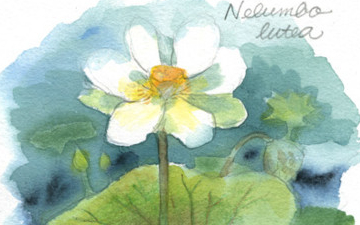Nelumbo lutea is a species of flowering plant of the order Proteales that is native to North America. Common names include American Lotus, Yellow Lotus, and Water-chinquapin.
Like the Asian species Nelumbo nucifera, the American Lotus is an emergent aquatic plant. It grows in lakes and swamps, as well as areas subject to flooding. The roots are anchored in the mud, but the leaves and flowers emerge above the water’s surface. The petioles of the leaves may extend as much as 2 m (6.6 ft) and end in a round leaf blade 33–43 cm (13–17 in) in diameter. Mature plants range in height from 0.8 to 1.5 m (2.6 to 4.9 ft).[1]
Flowering begins in late spring and may continue into the summer. The specific name means “yellow” in Latin and refers to the flowers, which may be white to pale yellow. The flowers measure 18–28 cm (7.1–11 in) in diameter and have 22-25 petals.[1]
The native distribution of the species is the southeastern United States, Mexico, Honduras, and the Caribbean. It has apparently been distributed northwards in the United States by Native Americans who carried the plant with them as a food source.[2]
(From Wikipedia, November 14th, 2010)
—
Nelumbo lutea is a species as magnificent as its Asian relative, N . nucifera , but it is less cultivated for ornament. It was probably originally confined to flood plains of major rivers and their tributaries in the east-central United States and carried northward and eastward by aborigines who used the seeds and tubers for food. The species is sometimes an aggressive, difficult-to-eradicate weed in ponds, lakes, and reservoirs.
Although Nelumbo lutea is often attributed to (Willdenow) Persoon, the spelling Nelumbium luteum used by Willdenow is an orthographic error for Nelumbo lutea (W. Greuter et al. 1994, Art. 61.4) that should be corrected, and Persoon’s later combination is superfluous.
The name Nelumbo pentapetala (Walter) Fernald, sometimes used for this taxon, was based on Nymphaea pentapetala Walter, a name of uncertain application that has been recently proposed for rejection (J. H. Wiersema and J. L. Reveal 1991).
(From EOL via Flora of North America, November 14th, 2010)
—




